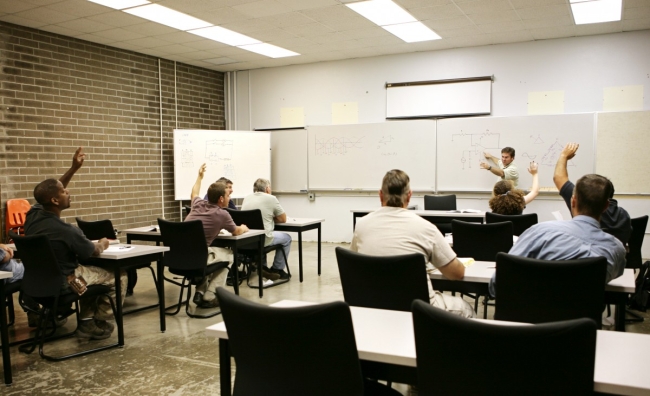You have /5 articles left.
Sign up for a free account or log in.

Istockphoto.com/lisafx
Remedial course work has long been viewed as a primary barrier to college completion, a black hole from which relatively few students emerge to earn a credential after being placed in the typically noncredit courses in mathematics and English.
Yet a new study found that reforms to remedial education, even a promising one that reaches back into high school, do little to move the needle on students’ credit completion or the likelihood of earning a college credential.
“We were hoping we’d see bigger effects on credit accumulation,” said Thomas Kane, an economist and Walter H. Gale Professor of Education at Harvard University’s Graduate School of Education, who still said the program was worth keeping and improving.
As a result, the study found that focusing student success initiatives on clearing or changing requirements for college remediation -- which has occurred via state policy in Florida, Texas and California -- will not substantially improve the nation’s college completion crisis.
“Learning this now will help us redirect those efforts to clear other potential logjams,” said Kane.
Kane is one of seven academics who coauthored the newly released working paper, which was published by the National Bureau of Economic Research and builds on a previous study. Angela Boatman, an assistant professor of public policy and higher education at Vanderbilt University, also was a coauthor.
The study analyzed the impacts of a well-established, statewide effort in Tennessee aimed at improving student success in remedial math. Created in 2012, the Seamless Alignment and Integrated Learning Support (SAILS) program seeks to shift college-level math remediation back to high school, to better prepare students to complete college-level math when they enroll at a postsecondary institution.
Under the program, high school students who require developmental course work in math, as determined by their junior-year ACT score, can fulfill that requirement by a hybrid online (meaning offered partially online and in-person) math course offered during their senior year. The modular course is run by high school instructors but modeled on the remedial math track offered by Tennessee community colleges.
By the end of their second year of college, the study found, SAILS participants on average had completed an additional 4.5 college credits compared to their counterparts without the program. That basically means they were able to complete an additional college-level course in place of the remedial math course that was waived for finishing the high school program, the study said.
SAILS also appeared to improve students’ perceptions of the usefulness of math and enjoyment of taking it. For example, student participants who were just below the remedial placement cutoff were more likely to perceive that their math course content would be useful in their careers, to say they were better prepared for college math and that they were interested in math compared to their peers just above the threshold.
Yet the gains didn’t show up in more tangible ways, as the study found that the removal of the remedial math requirement for SAILS completers did not lead to a burst of progress beyond that course.
“It does not seem that remediation requirements were the primary constraint getting in the way of college credit accumulation for students,” the paper said.
The study found no statistically significant impact from SAILS either on the proportion of students earning an associate degree or certificate within two years.
Likewise, despite the positive impact on students’ perceptions of math, there was no difference in math performance for students just above and below the remediation cutoff (according to an assessment and survey the researchers conducted with roughly 16,000 Tennessee seniors enrolled at high schools that administered SAILS).
That finding implies that the Tennessee program’s high school math remediation course “had little impact on students’ math achievement over and above the high school math course they would have taken otherwise.”
Remedial Reform as One Piece of Puzzle
In recent years, much of the energy around attempting to improve developmental education success rates has focused on an approach called corequisite remediation.
This method seeks to reduce the time and delay created by remedial requirements by allowing students to take college-level gateway courses in math and English at the same time they complete remedial course work, ideally with enhanced student supports, such as additional tutoring. California, Florida and Texas have pushed corequisite remediation at the state level, as have many community colleges around the country.
The new paper said both corequisite programs and ones like SAILS, which eliminate prerequisite remedial requirements by moving remediation to high school, seem to allow community college students to enroll in college-level, credit-bearing math more quickly and to accumulate an additional 1.5 college courses by the end of their second year.
“However, such findings also suggest that the prerequisite remediation requirement is not the primary barrier to credit accumulation and degree completion for many students -- since, if it were, we would have expected a larger burst of credit accumulation than the single course,” the paper said. “Because the SAILS course was modeled on the course delivered in community colleges, our findings raise doubts about the impact of those courses in remediating students’ math skills as well.”
The researchers said student success efforts should include attempts to alleviate other barriers to graduation, through better college advising, clearer course progression, so-called meta majors featuring common course requirements for first-year students and other promising, research-backed interventions.
Kane also said the findings do not suggest that SAILS and other, similar programs should be abandoned. In fact, the paper suggests that perhaps math remediation should be moved to earlier in high school.
“It may be that starting in 12th grade is too late,” Kane said.
The paper pointed to the positive impacts of a ninth-grade, double-period algebra course used in the Chicago Public Schools, which resulted in bumps to test scores, high school graduation rates and the likelihood of students enrolling in college.
In addition, the study said that the self-paced, hybrid online approach of SAILS could be revisited with an eye to improving its effectiveness with low-achieving students.
“Boosting degree completion will require a more effective model of math remediation -- either in high school or college -- or the elimination of other barriers to completion, such as inadequate advising or the level of math required in gateway college courses,” the paper concluded.








